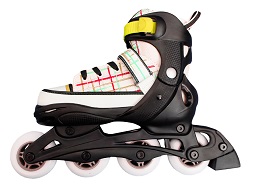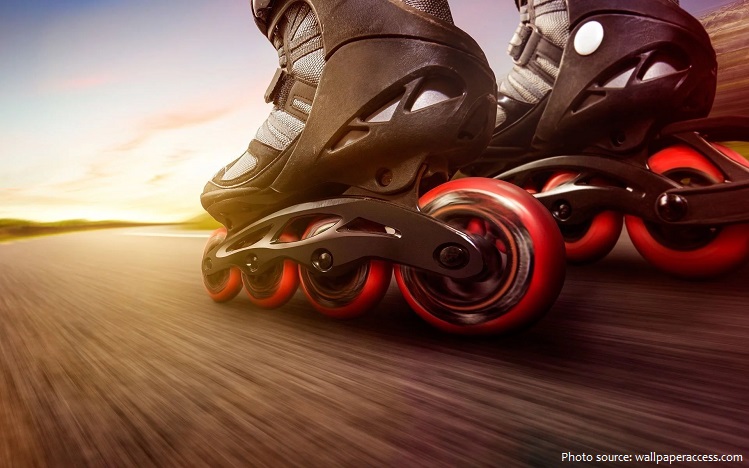
Inline skates are a type of roller skate used for inline skating.
They typically have two to five polyurethane wheels depending on the style of practice, arranged in a single line by a metal or plastic frame on the underside of a boot.
The in-line design allows for greater speed and maneuverability than traditional (or “quad”) roller skates. Following this basic design principle, inline skates can be modified to varying degrees to accommodate niche disciplines.
Inline skating is commonly referred to by the proprietary eponym “rollerblading”, or just “blading”, due to the popular brand of inline skates, Rollerblade.
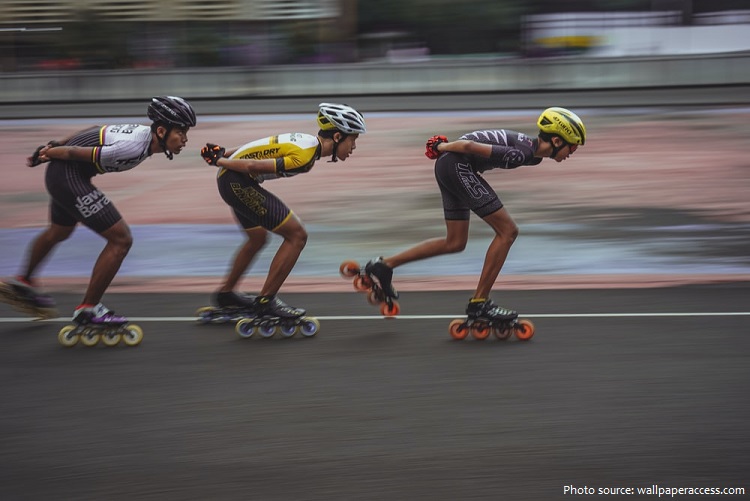
Inline skates were created in the early 1700s when a Dutch person attached wooden spools to strips of wood and nailed them to his shoes.
In 1863, an American developed the conventional rollerskate model, with the wheels positioned side by side, and it became the skate of choice.
The first US patent for modern in-line skates, designed to behave like ice runners with individually sprung and cushioned wheels, was granted in July 1953 to Ernest Kahlert of Santa Ana, CA. In September of 1953 an advertisement by the “Rocket Skate Company” for two wheel inline skates appeared in Popular Science. They were briefly described in the April 1950 issue of Popular Mechanics and again in the April 1954 issue of Popular Science in the section called “New Ideas from the Inventors”. In Canada in 1972, Mountain Dew attempted to sell Mettoy’s product the “Skeeler”, an inline skate that was developed for Russian hockey players and speed skaters.
In 1978, the German branch of SKF presented the “Speedy”-System, but the product was cancelled less than one year from market, as the management did not want a consumer product in the portfolio of the company.
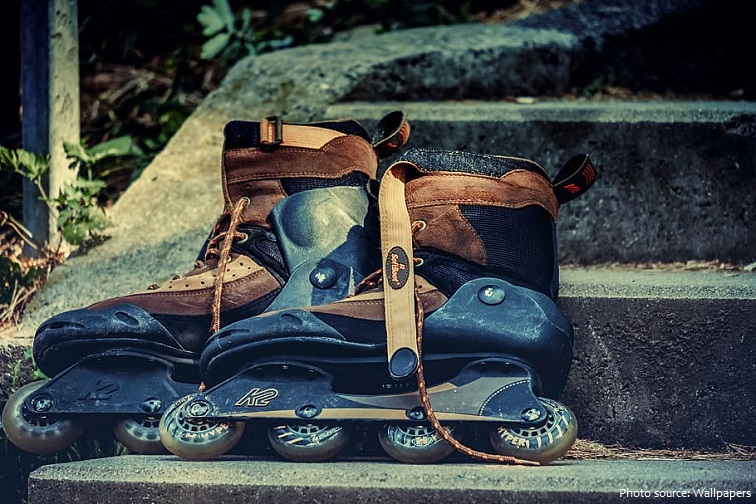
In 1980, a group of ice hockey players in Minneapolis, Minnesota were looking for a way to practice during the summer. Scott and Brennan Olson formed the company Rollerblade, Inc., to sell skates with four polyurethane wheels arranged in a straight line on the bottom of a padded boot. They sold the company in 1984 to Bob Naegele jr., who advertised to the general public and sold millions.
The first commercially available inline skate for this form of roller skating is in 1987 by Rollerblade. In 1996, Jason Lewis completed the first solo crossing of the United States on inline skates, part of Expedition 360, a successful attempt to circumnavigate the globe using only human power. En route he was hit by a car in Colorado, breaking both legs. After nine months he completed the journey from Fort Lauderdale to San Francisco. In 2012, Kacie Fischer became the first woman, and the fastest person, to
inline skate across the United States – she skated from California to Florida in 47 days.
There are different types of inline skates for different types of skating such as aggressive skating, speed skating, inline hockey and artistic inline skating. Those differ in the boots, frames and wheels that are used.
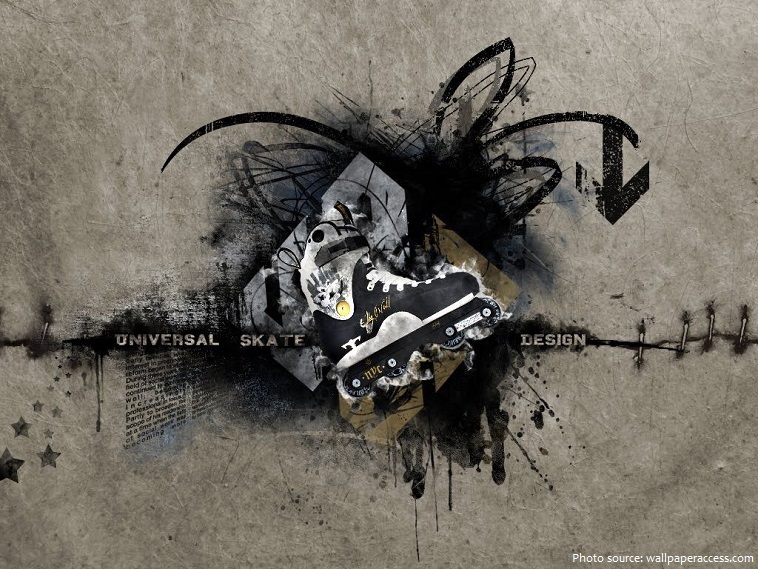
Aggressive skating is primarily focused on the execution of tricks in the action sports canon. Aggressive inline skates are specially modified to accommodate grinds and the jumping of large gaps.
Alpine skating owes its existence to skiing, because many skiers commonly practiced it in the summer months during its origins, as it helped them to train despite the lack of snow. Skaters complete a course marked by gates while descending at high speeds. Its basic movements are therefore similar to those of downhill skiing and many athletes regularly practice both modalities
Freestyle skating is a form of inline skating performed on flat ground and refers collectively to the disciplines for which competitions are organized by the International Freestyle Skaters Association. Currently IFSA has defined three disciplines which must be offered by any competition they sanction: freestyle slalom, speed slalom, and free jump.
Inline hockey is a variant of hockey played on a hard, smooth surface, with players using inline skates to move and hockey sticks to shoot a hard, plastic puck into their opponent’s goal to score points. The sport is a very fast-paced and free-flowing game and is considered a contact sport, but body checking is prohibited. There are five players including the goalkeeper from each team on the rink at a time, while teams normally consist of 16 players. There are professional leagues, one of which is the National Roller Hockey League (NRHL). While it is not a contact sport, there are exceptions, i.e. the NRHL involves fighting.
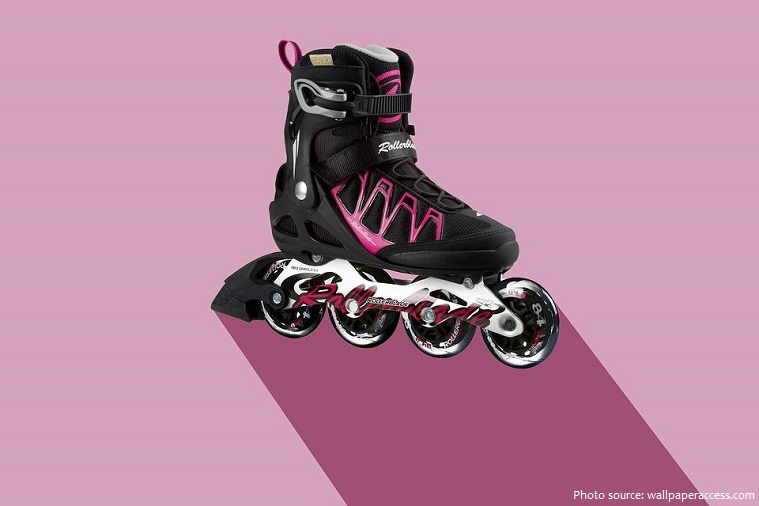
Also known as inline racing, speed skating is the sport of skating (usually on flat surfaces, such as roller-rinks) with the intent to beat the opponent’s time score or get to the finish line first.
The fastest speed on inline skates (downhill) is 124.67 km/h (77.47 mph) and was Sandro Bovo (Italy), in Teutonia, Brazil, on 21 February 2016.
The longest distance covered on roller skates is 8,596 km (5,341.3 mi) achieved by Peter Bögelein (Germany). Bögelein departed Würzburg, Germany on 1 June 1986 and returned to Würzburg on 16 September 1986.
The longest inline skating chain involved 321 participants, achieved at an event organised by Club Patinadores de Sevilla (Spain), in Seville, Spain, on 23 April 2016.
The largest inline skating marathon is the 42nd BMW BERLIN-MARATHON Inlineskating which had 4,680 finishers, and was held Berlin, Germany, on 26 September 2015.
The record for the highest 720 spin on inline skates is 4.25 m (13.94 ft) by Romain Godenaire (France) on the set of L’Ete De Tous Les Records, Port Medoc, France on 21 July 2005.
The record for the most consecutive flatspins performed on inline skates is 16 and was set by Stephane Alfano (France) on the set of L’Ete De Tous Les Records, Port Medoc, France, on 18 July 2005.
The record for the highest McTwist on inline skates is 2.35 m (7.7 ft) and was set by Taïg Khris (France)on the set of L’Été De Tous Les Records in Benodet, France on 2 August 2004.
